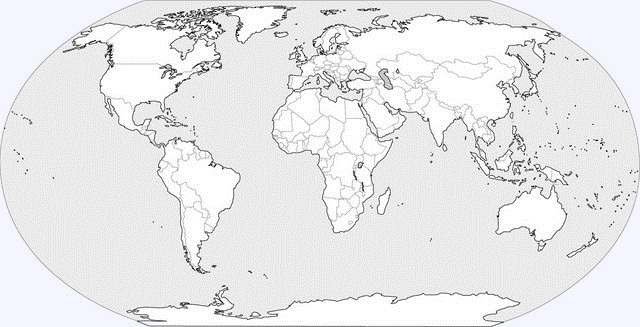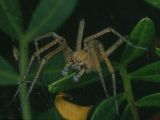|
Nombre común en ingles:
Velvet spiders
Nombre común en castellano:
Se desconoce
Familias similares:
Género tipo:
Eresus Walckenaer, 1805
Diagnosis:
Small to large araneomorph
spiders; three tarsal claws; cribellate; entelegyne; eight eyes;
carapace convex, rectangular; median eyes situated close together,
with lateral eyes widely spaced; body usually clothed in a dense
layer of short plumose setae.
Caracteres descriptivos:
Caparazón:
rectangular; high in Eresinae, flattened in Penestominae; densely
clothed in setae; clypeus protruding centrally; fovea circular but
variable in depth; males of Dresserus and some Stegodyphus with
horn-like extensions at anterolateral edge of carapace. Esternón:
narrowed in front; labiosternal groove distinct. Ojos: eight;
both pairs of median eyes close together, with lateral eyes wide
apart; posterior lateral eyes far back on carapace, closer to the
front in Penestominae. Quelíceros: strong; anterior margin of
cheliceral furrow armed with a strong chitinous keel which may be
serrated. Piezas bucales: endites with well-developed
serrula; labium rounded apically. Patas: three claws; legs
usually short and stout; tarsi usually united to metatarsi by almost
rigid joints; densely clothed in setae. Palpo femenino:
unmodified. Abdomen: rounded to oval; densely clothed in
plumose setae; frequently with pattern. Hileras: anterior
spinnerets thick, conical, multi-segmented; spinnerets of Scothyra
and Dorceus modified, with only anterior pair well developed. Sistema respiratorio:
two booklungs; posterior tracheal spiracle close to spinnerets.
Cribellum: well-developed; cribellar plate oval; divided, or 3-4
partite in Dresserus; 2-partite in Gandanameno and other genera;
absent in Wajane. Calamistrum: uniseriate, usually along
entire length of metatarsi IV in Eresinae; shorter in Penestominae;
absent in Wajane. Genitalia: epigyne usually simple, usually
with a median septum and linear depression latero-caudally; internal
structure usually simple; male palp short, thick and simple; tibial
apophyses absent in Eresinae; Penestominae with tibial process
large, bifurcated and median apohysis complex. Tamaño corporal:
3-35 mm. Color: various hues of dark brown, yellowish brown
or grey; abdomen sometimes with distinct pattern formed by white,
orange, pale blue or red setae, some species are characterized by
remarkable sexual dimorphism, where males are of bright aposematic
coloration.
Estatus taxonómico:
Platnick et al. (1991) considered the oecobiids and eresids to be
sister taxa, while Coddington (1990) considered them to be adjacent
outgroups for the remaining Entelegyne. Coddington & Levi (1991) and
Coddington et al. (2004) placed them in the superfamily Eresoidea
together with the Oecibiidae and Hersiliidae. Several genera have
been revised: Dorceus (El-Hennawy, 2002); Scothyra
(Dippenaar-Schoeman, 1990); Penestomus (Dippenaar-Schoeman, 1989);
Stegodyphus (Kraus & Kraus, 1988); Wajane Dippenaar-Schoeman, 1989).
Distribución: Afrotropical
and Palearctic Regions with high diversity in Africa and a few
species of Stegodyphus known in Brazil and the Indomalasian region.

Estilo de vida: Live in
variety of habitats. They construct retreat webs and are found on
the ground in burrows or on plants. Three species of Stegodyphus are
social.
Bibliografía:
-
Coddington, J. A.
1990. Ontogeny and homology in the male palpus of orb-weaving
spiders and their relatives, with comments on phylogeny (Araneoclada:
Araneoidea, Deinopoidea). Smithson. Contrib. Zool. 496: 1-52.
-
Coddington, J.A. &
Levi, H.W. 1991. Systematics and evolution of spiders (Araneae).
Ann. Rev. Ecol. Syst, 22: 565-592.
-
Dippenaar-Schoeman,
A.S. 1989. The African species of the subfamily Penestominae (Araneae:
Eresidae): with description of two new species. Phytophylactica 21:
131-134.
-
Dippenaar-Schoeman,
A.S. 1990. A revision of the African spider genus Seothyra Purcell (Araneae:
Eresidae). Cimbebasia 12: 135-160.
-
Dippenaar-Schoeman, A.S. & Jocqué,
R. 1997. African Spiders: An Identification Manual. Plant Protection
Res. Inst. Handbook, no. 9, Pretoria, 392 pp.
-
El-Hennawy, H.K.
2002. Revision of the North African spider genus Dorceus C. L. Koch,
1846 (Araneida: Eresidae). Serket 8: 57-72.
-
Kraus, O. & Kraus,
M. 1988. The genus Stegodyphus (Arachnida, Araneae). Sibling
species, species groups, and parallel origin of social living. Verh.
naturwiss. Ver. Hamburg 30: 151-254.
-
Lehtinen, P.T. 1967.
Classification of the cribellate spiders and some allied families,
with notes on the evolution of the suborder Araneomorpha. Ann. Zool.
Fenn. 4: 199-468.
-
Platnick, N.I.,
Coddington, J.A., Forster, R.R. & Griswold, C.E. 1991. Spinneret
morphology and the phylogeny of Haplogyne spiders (Araneae,
Araneomorphae). Am. Mus. Novit. 3016: 1-73.
2 géneros y 4 especies presentes en la Península Ibérica:
|
| |
- E. kollari
Rossi, 1846 |
| |
- E. sedilloti
Simon, 1881 |
| |
- E. solitarius
Simon, 1873 |
|
| |
- S. lineatus
(Latreille, 1817) |
| |
|
 |